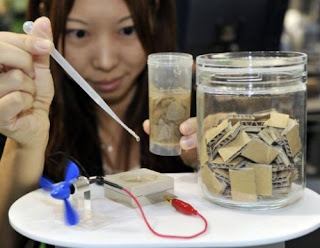
A team of researchers at the University of Wisconsin-Madison managed to come up with a device that can produce power from airflow that comes from human breathing.
Initially scientists wanted to create a small and flexible apparatus that would utilize the low airflow speed of about 2 meters per second - a speed of normal respiration.
In order to reach their goal, the team decided to use a plastic microbelt made of polyvinylidene fluoride (PVDF) that vibrates as it is being passed by low-speed airflow. PVDF allows the belt to collect electric charge during mechanical stress.
Microbelt produces enough electrical power from breathing to operate small electronic gadgets. In the image the belt is colored in yellow. The other components of the device make up a simulated lung that produces the airflow.
Scientists believe that someday their invention could be used as a power source incorporated into implantable medical devices.





